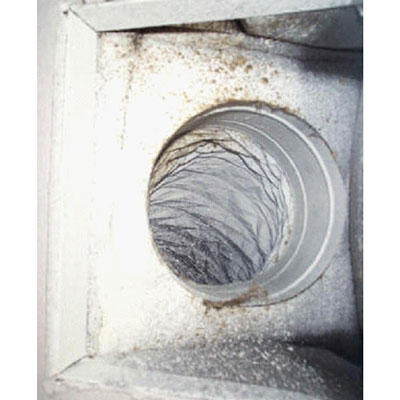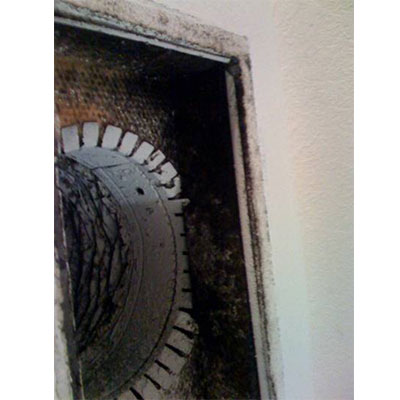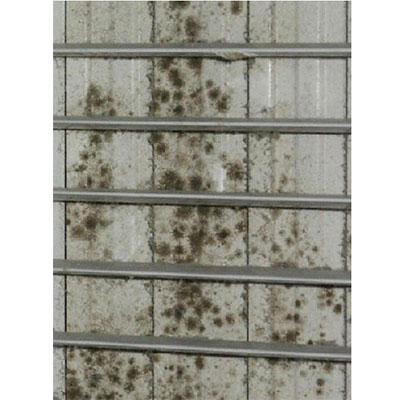Do you have air conditioner mold? Just discovered mold in your ac unit? Or seeing or air ducts? We are your number one resource with the best air conditioner removal tips. But first let us inform you on a couple of things…
Why are Air Conditioners, AC Equipment and Air Ducts such Mold Factories?
To understand why mold grows in ac units, air ducts and air vents it is imperative to know how an air conditioner works. Below you will find several reasons why an air conditioning system can be a perfect habitat for mold spores to grow. Use a strong flashlight to search for mold growth inside window air conditioners and air conditioning duct registers (after removing the register grill).
- The operating air conditioner continually bring into the air cooling system new air that contains abundant airborne mold spores and organic dust and dirt, which are the mold food for the mold spores to eat to grow into mold colonies.
- The operating air conditioners then spread airborne mold spores from their internal mold growth into the rooms being cooled via the outward air flow from the air con units, resulting in massive mold cross contamination of the house, office, or workplace.
- If heating, ventilating, and air conditioning (HVAC) systems are turned off at night or for many hours in the daytime in workplaces or in homes, the non-operation of the air conditioning can allow humidity to build, condense, and cause big-time mold growth.
- The HVAC system may be too small in capacity and design to provide adequate fresh air intake and enough air conditioning to prevent mold growth.
How to Test if your Air Conditioner has Mold?
One option to test your heating/cooling equipments and ducts for elevated levels of mold spores and mold growth is to use a mold test kit. You tape the open side of the mold test kit to the outside of the HVAC grill register or window air conditioner air supply grill so that the sticky side of the kit is facing the outward air flow from the heating/cooling duct register. Run your air conditioning system or window air conditioner on fan ventilation (no heating or cooling) for 10 minutes. Then, remove the mold test kits, put the lids back on, seal the outside edge of the closed mold test kit lab dishes and then watch for mold growth over a 7 day time period.
Does a High Ozone Generators Kill Mold in Your AC?
No, as the EPA states: “an ozone generator has non tot little effect on mold growth and contamination in air ducts and ac units if public health standards are met.” Even with a 5-10 times higher concentration – which is dangerous if people are present – would not fully remove mold.
Mold Growth in Air Conditioning Systems
Mold can accumulate and grow when it’s spores are caught in the filters of air handlers, air conditioners, and heating/cooling systems. The mold grows on dust and dirt also collected on the air conditioning filters. One of the best places to inspect for mold problems is to visually inspect the filters and take mold samples. In the lab an analysis will tell you more about the mold species living in your ac unit. Air handling and heating/cooling systems bring mold anywhere inside your home or building. If there is mold growth in the air conditioning/heating equipment and air ducts you can identify the mold on the air vents. If so, call a professional because your entire house or building probably needs to undergo an in depth mold inspection. Similarly, the entire home might need to have intensive mold remediation.
Air Conditioning Mold Pictures
Pictures and photographs of mold growth inside air ducts, registers, and air vents. Air conditioner mold growth is one of the worst health threats to the health of building occupants, residents, and guests.
Is Mold in AC Units and Air Ducts Dangerous?
If an air conditioning system (AC-system) is not properly maintained your health can be compromised. Symptoms of allergic rhinitis, an inflammation of the nasal passages, and asthma can worsen when dust and mould form as a result of poor maintenance. People who spend a lot of time in air-conditioned office buildings have more health problems, said a study done in France by Dr Mark Mendell and published in the International Journal Of Epidemiology in 2004. These problems include breathing difficulties, skin irritations, headaches and tiredness.
Dr Mendell said it could be because the ventilation systems in buildings, especially those with AC systems, spread contaminants into the air in the room. Also, wet ceilings and walls, from condensation after the AC system is switched off, can breed bacteria and mould which are associated with increased risk of respiratory problems and asthma.
Cooling coils and drip pans in an ac unit remain moist and can accelerate the growth of micro-organisms and fungi which get picked up in the air flow. There is even the possibility of contracting Legionnaires’ disease, a type of pneumonia caused by breathing in the bacteria-laden mist from the AC’s cooling tower.
Even increased obesity has been linked to too much air conditioning. ‘Air-conditioning is said to decrease the metabolic rate, therefore causing people to put on more weight,’ according to the University of Alabama. However, they cautioned that more research has to be done to establish a direct link between the two.
Then there is the sick building syndrome. The United States’ Environmental Protection Agency has said that it can arise if the AC system does not effectively distribute air in the building. This can lead to symptoms like headaches, irritation in the eyes, nose, or throat, dry or itchy skin and dizziness.
Elaborating the chief culprit for such illnesses is poor indoor-air quality, not how long one has been in an air-conditioned place. This is caused by the accumulation of pollutants indoors which are not adequately removed by the existing ventilation system. These pollutants include bacteria, viruses, mold and even dead rats in the ventilation ducts.
Carbon dioxide may accumulate too and you may experience some headaches. Experts suggested that windows be opened at the start of the workday to allow fresh air in. Objects, like old books, which grow mold should be removed. Drinking lots of fluids helps. Most importantly, if you have a contagious disease, do stay at home or if you really need to be at work, use a face mask to protect others.
Useful Resources:
- Should You Have the Air Ducts in Your Home Cleaned? – Source: EPA
- Mold Glossary of Terms
- Air Conditioning as a Risk for Increased use of Health Services




